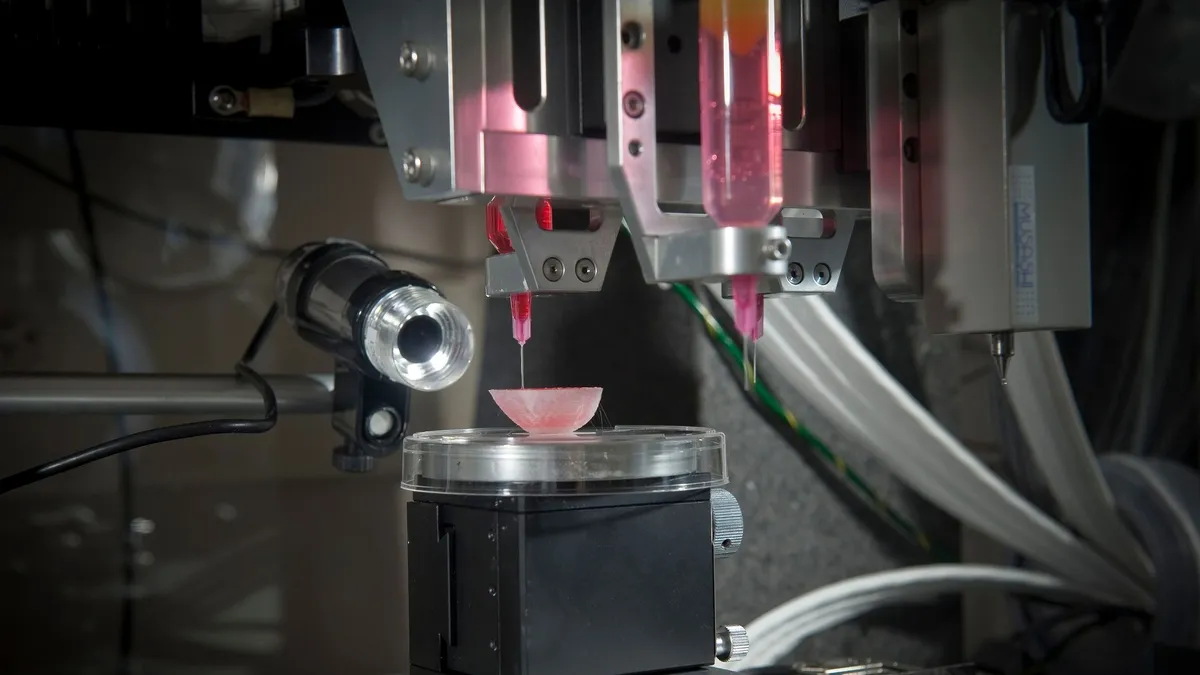The human body is an intricate machine, composed of trillions of cells meticulously arranged into tissues and organs. When these building blocks malfunction or break down entirely, disease sets in. Traditionally, medicine has relied on surgery, pharmaceuticals, and transplants to address such issues. However, a revolutionary technology is emerging that promises to rewrite the script: bioprinting.
Bioprinting, also known as 3D bioprinting, utilizes biocompatible materials, living cells, and intricate printing techniques to create functional biological structures. Imagine a 3D printer that, instead of plastic or metal, uses a complex cocktail of human cells and biomaterials to build tissues, organs, or even entire implants. This is the essence of bioprinting, a technology with the potential to revolutionize healthcare, drug discovery, and even manufacturing.
From Pixels to Tissues: The Mechanics of Bioprinting
Bioprinting works on similar principles as traditional 3D printing. A digital blueprint, often derived from medical scans or computer-aided design (CAD) software, dictates the structure to be created. This blueprint guides the printer as it deposits bioinks, a specialized type of ink containing living cells suspended in a biocompatible material that provides structure and support. The bioink can be composed of various materials, including hydrogels, synthetic polymers, or even natural materials like collagen or fibrin.
The printing process itself can take different forms. Inkjet bioprinting utilizes a printhead to deposit tiny droplets of bioink, much like a standard inkjet printer. Extrusion bioprinting, on the other hand, utilizes a continuous stream of bioink deposited through a nozzle, allowing for more intricate structures. Finally, laser-assisted bioprinting uses a laser to precisely arrange cells within a biomaterial scaffold.
The Potential of Bioprinting in Healthcare
Bioprinting holds immense promise for the medical field. One of the most exciting applications lies in tissue and organ transplantation. Currently, patients wait years for a suitable organ donor, with many succumbing to illness before an organ becomes available. Bioprinting could potentially create transplantable human organs on demand, eliminating waiting lists and saving lives. Researchers are already experimenting with bioprinting skin grafts, heart tissues, and even simple blood vessels.
Beyond transplantation, bioprinting can be used to create complex 3D cell cultures for drug discovery and testing. Pharmaceutical companies currently rely on animal models to test new drugs, a process that is expensive, time-consuming, and not always accurate in predicting human responses. Bioprinted human tissues could offer a more reliable and efficient way to test drugs and develop personalized therapies.
Furthermore, bioprinting holds immense potential for regenerative medicine. By printing damaged tissues or even entire bones, bioprinting could offer new options for treating injuries and degenerative diseases. Imagine a future where damaged cartilage in the knee is simply bioprinted, or a fractured bone is repaired using bioprinted scaffolds that promote healing and regeneration.
Challenges and Ethical Considerations of Bioprinting
While the future of bioprinting looks bright, there are significant challenges to overcome. One major hurdle is the complexity of mimicking the natural cellular organization found in human tissues and organs. Bioprinted structures need to develop vascular networks to deliver nutrients and oxygen throughout the tissue, a feat that is still under development.
Another challenge lies in the limited availability of biocompatible materials that can support and guide cell growth. Additionally, ensuring long-term viability and functionality of bioprinted tissues within the human body requires further research.
Ethical considerations surrounding bioprinting are also critical. The potential for replicating complex human structures raises questions about the ethics of creating human embryos for research purposes. Additionally, accessibility to this technology must be carefully considered to ensure equitable access to these potentially life-saving treatments.
Beyond Healthcare: Bioprinting in Manufacturing
Bioprinting’s applications extend beyond healthcare. The technology has the potential to revolutionize the manufacturing of various products. Imagine bioprinting customized prosthetics that perfectly fit an individual’s needs or bioprinting tissues for use in the fashion industry for sustainable and cruelty-free leather alternatives.
Bioprinting could also lead to advancements in food production. Imagine printing customized steaks with controlled fat content or even bioprinting complex, nutritious food structures for astronauts on long-duration space missions.
The Future of Bioprinting: A Collaborative Endeavor
Bioprinting stands at the intersection of engineering, medicine, and biology. To unlock its full potential, collaboration across these disciplines is crucial. Bioengineers will need to develop innovative bioinks and printing techniques, while biologists will need to optimize cell culture strategies and understand how bioprinted structures integrate with the human body.
Regulatory frameworks and ethical guidelines will also need to be developed to ensure the safe and responsible use of this revolutionary technology. As scientists, engineers, and policymakers work together, bioprinting has the potential to transform our world, ushering in an era of personalized medicine, sustainable manufacturing, and a deeper understanding of human biology.
Conclusion
Bioprinting is a rapidly evolving technology with the potential to reshape healthcare, drug discovery, and even manufacturing. While challenges remain, the potential benefits are undeniable. Bioprinting offers hope for a future where waiting lists for organ transplants become a thing of the past, where drug discovery becomes faster and more accurate, and where regenerative medicine allows us to heal and repair our bodies in entirely new ways. As research and development continue, bioprinting has the potential to redefine the boundaries of medicine and technology, paving the way for a healthier and more sustainable future for all.
The journey of bioprinting is far from over. It is a field brimming with possibilities, waiting to be explored and brought to fruition. As with any new technology, public education and open discussions are essential to ensure responsible development and implementation. By fostering collaboration and open dialogue, bioprinting can become a powerful tool for improving human health and well-being, ushering in a new era of medical innovation.

